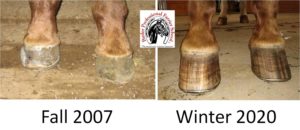Congenital Deformities
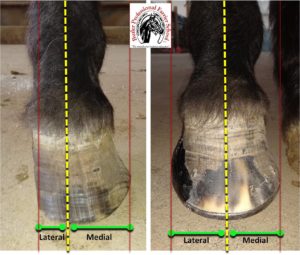
Before and after shoeing a right hind foot of an older horse with a congenital deformity. Left picture: the right hind foot after trimming. Note that there is more foot under the medial side of the center of gravity (yellow dashed line) than there is on the lateral side. The horse is bearing more weight on the outside (lateral side); Right picture: the same foot after a therapeutic lateral heel support shoe is applied. Note that the medial and lateral sides are nearly equal under the center of gravity (yellow dotted line) allowing the horse to be more comfortable. Vettec Adhere was injected to fill in the extra space above the full shoe.
Some horses have crooked legs. Some of these horses become lame because of the deformatity. Other horses seem to learn how to “get along” with the deviated limb and though it is unsightly, the horse doesn’t seem to be affected. Farriers are often called upon to work on these crooked-legged horses. There are some factors that farriers, veterinarians and horse owners can influence to improve a horse’s comfort and mobility including therapeutic shoeing, corrective surgery, and good management. Most of what farriers do is accommodation—not correction—of crooked legs.
Legs can become crooked for two major reasons:
1) Horses can inherit a crooked conformation from their parents and genetic bloodline. This is seems to be the most common cause of crooked limbs. It is estimated that horses that have crooked legs have a 65% chance of passing it on through the blood lines.
2) Horses can develop crooked conformation from their environment before birth (in the uterus) or after birth (injury, habit, poor management practices). When a horse develops a crooked leg inside the womb of the mare it is called a congenital deformity. Multiple legs can be affected but usually, it is just one. In other words, all the other feet may develop normally while one unfortunate leg develops abnormally, because of the way the foal sits inside the mare. If a small mare is carrying a large foal, there may not be enough room in the uterus for the foal to develop normally.
Helping a horse with a congenital deformity is best done when the foal is young. Bones are still pliable at a young age before growth plates (epiphyseal growth plates) close. Growth plates of bones closest to the ground (coffin, pastern and cannon bones) close the soonest while growth plates of bones closer to the body (humerus, femur) close later in development. There is a narrow window of time (birth to about 9 months) that the development of bones can be influenced by a competent farrier’s application of a therapeutic shoe. Lightweight shoes (plastic or aluminum) are usually applied to foals to provide support and leverage without increasing the weight on the end of the limb. Providing support to a crooked leg at a young age can help a horse to grow out of a crooked conformation, although success is not guaranteed.
Several years ago, we obtained a young weanling mare that was lame at Butler Professional Farrier School. She had a crooked right front foot that turned inward because of a base narrow conformation. The hoof was beginning to distort as the foot glared to the inside while the outside of the foot took more weight. We applied a shoe with support on the lateral side. As she grew, and we trimmed and reapplied a therapeutic shoe regularly (every 4 to 6 weeks), she seemed to “straighten up.” Today, at 13 years old, her right front hoof looks almost completely straight (despite a toed out (fetlock valgus) condition) and she has not been lame due to a crooked foot on that side ever since. In this case, the application of a therapeutic shoe at the critical time was successful.\
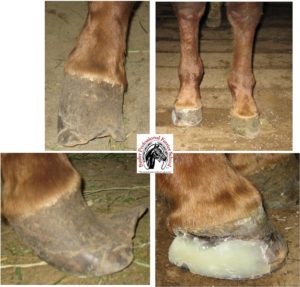
This weanling mare had a crooked right front foot that was growing distorted. By placing a later support shoe under the horse’s center of gravity, the foot was allowed to grow straight. Vettec Superfast was applied to prevent another horse from stepping the shoe off.
When a horse develops with a crooked limb and no support is given at the critical time to encourage straighter growth, the horse usually ends up with a permanent deviation. Sometimes, when this happens, the crooked leg puts stress on joints and causes a horse discomfort. This is usually evidenced by a lame stance or gait or an opposite limb taking more weight to compensate for the afflicted leg. If this type of horse is neglected and the hoof is allowed to grow in a distorted manner, the problem becomes much worse.
Farriers can still help such horses with therapeutic trimming and support shoes, though it should be noted that the goal is comfort. The crooked leg will likely not “straighten up” after the bones have already finished developing. Farriers should care for the crooked leg regularly to prevent the situation from getting worse.
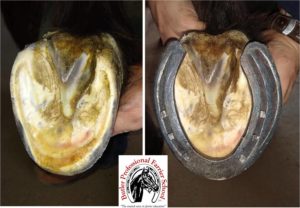
A shoe fit full to the outside over the heel (lateral heel extension shoe) helps this horse to stand more evenly and distribute pressure evenly over the entire limb.
Recently, at Butler Professional Farrier School, we obtained a 25 year old mare with a crooked right hind foot that turns inward (fetlock varus). Though she doesn’t seem to be in pain as she moves, the mare was noticeably putting more weight on the left hind foot to dissipate weight-bearing on the crooked foot. It became even more apparent, when the left hind foot was lifted and the right hind foot had to take more weight. Imagine standing on the outside of one foot and then lifting your opposite leg. You would feel a lot of pressure and discomfort in your ankle.
Because the horse was putting more weight on the outside heel of the crooked foot, we made a lateral heel support shoe that helped to put the crooked leg under the horse’s center of gravity. After setting the shoe, we put the foot down to observe how she would take it. She immediately let out a big sigh and started licking and chewing. She also loaded the crooked foot and relaxed the opposite limb! She loaded the crooked foot at first so much that medial side of the foot came off the ground. After about ten minutes, she was loading the foot evenly.
Horses with congenitally crooked legs can be helped. At a young age, there is a better chance of success for helping a horse to develop normally. Horses that didn’t have access to a competent farrier at a young age may still be helped and made to feel comfortable if a farrier is skilled enough to recognize a problem, offer a solution and make adjustments as necessary by reading the horse’s response.
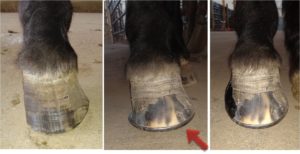
After the shoe was set (middle picture) on this older horse with a congenital deformity, she really loaded the outside heel; so much so in fact that the medial toe (red arrow) came off the ground. In about ten minutes she was loading the foot equally (right picture). Vettec Adhere was injected on the hoof wall to prevent another horse from stepping the shoe off.
Related Posts
-
Osteomyelitis is distinguished from pedal osteitis in that t...Mar 21, 2019 / 0 comments
-
If you want to work with horses and the people who value the...Sep 29, 2011 / 0 comments
-
Doug Bradbury of Derbyshire, England (pronounced Darbyshire)...May 21, 2020 / 0 comments
Blog Categories
- Anatomy
- Best Business Practices
- Conformation
- Current Events
- Customer Service
- Draft Horse Shoeing
- Equine Soundness
- Essential Anatomy Kit
- Farrier Careers
- Farrier training
- Foal soundness
- Horse Care
- Horse Foot Care
- Horse Owner Tips
- Horsemanship
- Horseshoeing
- Horseshoeing History
- Iron and Forge Work
- Student Spotlight
- Uncategorized
- Veterinary Care
Blog Archives
Contact Us
Butler Professional Horseshoeing School
495 Table Road
Crawford, NE 69339
(800) 728-3826
jacob@dougbutler.com
Subscribe to Our Blog
Get Our Free e-Book!
If you think you want to become a farrier (or know someone who does), this book can help you make that decision. Horse owners will learn the importance of choosing a qualified farrier and how to select the “right” one.
[ Get the e-Book Now! ]
- Follow:

